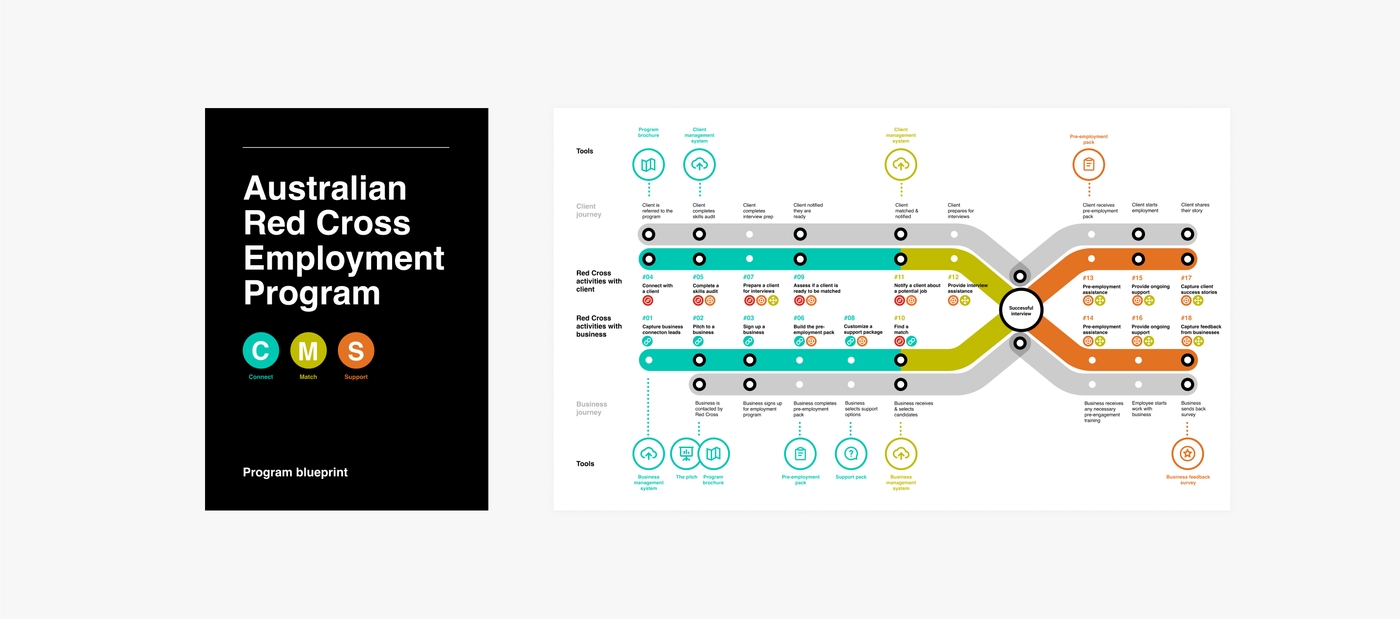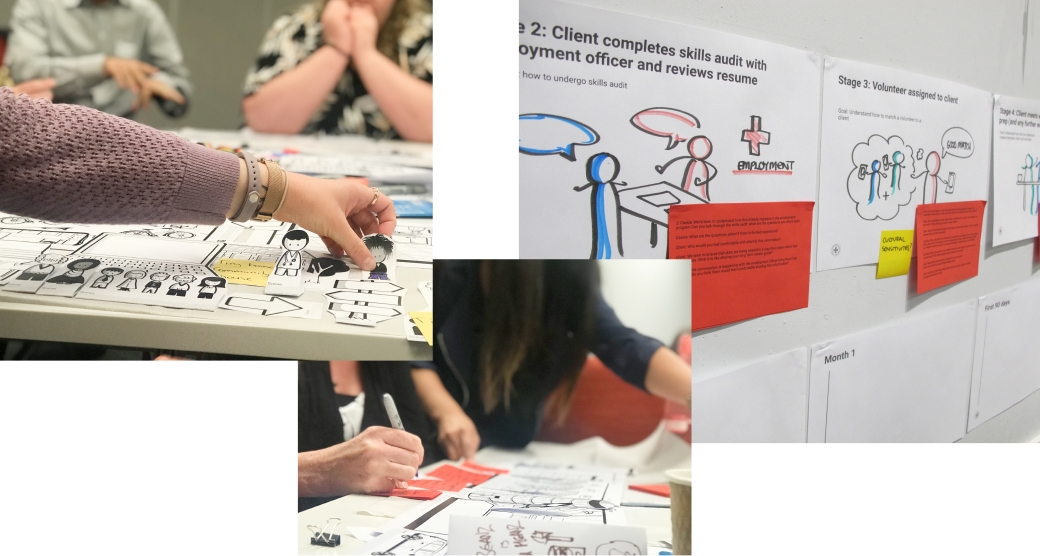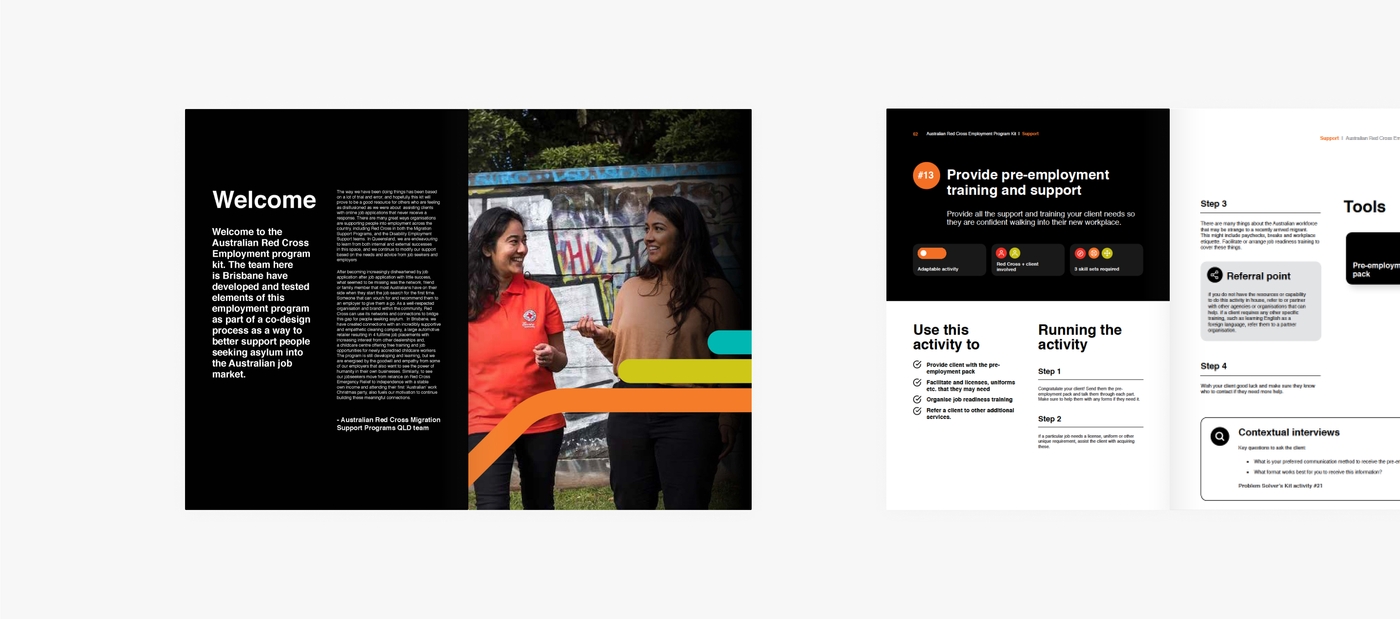Our research into these interconnected needs — housing, social inclusion, mental health — turned into a service design project that delivered an adaptable and testable employment program. The service connects people seeking asylum with businesses that have meaningful employment opportunities. After building on the success of a pilot in Brisbane, updated tools and activities are being rolled out to Australian Red Cross offices countrywide to empower staff to refine and test the program in more communities.

The brief was broad: improve the lives of people seeking asylum in Australia.
It was a brief that Portable’s designers and strategists leapt at, but that required the team, and client, to be open to and comfortable with embracing the ambiguity that comes with tackling such a complex problem. To start, Australian Red Cross and Portable defined what would guide us to a final outcome, covering user research, co-design activities, key milestones and a pilot along the way.
Initial user research included interviews with people seeking asylum, volunteers, case workers and Australian Red Cross staff. We spoke with many people and uncovered a complex, interconnected web of needs from housing to social inclusion to mental health. To narrow the focus, we explored ideas and concepts around these themes with people seeking asylum through structured conversations. Alongside interviews, Portable held a number of co-design workshops with Australian Red Cross staff as well as experts from across the humanitarian sector to both understand the landscape of current services and programs, but also to generate a host of creative ideas for interventions.
To conclude our discovery phase of research, Portable produced a report to communicate our insights and recommendations for service improvements, as well as areas for further exploration. Believing strongly in the power of communicating the voice of the people we were designing for, we wanted to ensure that our report got cut-through within the organisation, and didn’t just end up a PDF sitting in someone’s inbox. We designed ‘I am living question mark’ — a web experience that leads into our report, featuring quotes from people we spoke with.
Whilst a single intervention in any of the ‘problem spaces’ seemed unlikely to solve them all, finding meaningful employment for people seeking asylum was identified as a keystone — beyond a pay check, being engaged in work is likely to improve many of the other issues faced by people — housing, mental health, social inclusion — by connecting individuals with a network of people in their community, and giving them a sense of purpose and hope in the future.
Additional research was conducted, now centred around employment, to further understand the barriers. We found that many people had difficulty finding employment due to uncertain visa status, overseas qualifications and English-language difficulties, as well as the perceptions and attitudes of those providing work opportunities.
The solution was to design a service that developed meaningful partnerships between Australian Red Cross and businesses, to understand and help break down barriers businesses face when hiring people seeking asylum.

Connect, match and support
The development of the prototype service drew on the learning of the Australian Red Cross in Brisbane, where a staff member had begun using connections with employers to identify job opportunities. The value of developing partnerships with small and medium sized businesses became clear. We also needed to match job seekers with appropriate jobs and provide support to employers and those recently employed.
The ‘Connect, Match, Support’ framework was developed and it guided documentation of the employment program, as well as a staff toolkit with activities, methods and tools to put the program into action.
This was already happening in Brisbane. Our job was to capture and learn from the staff already doing great work on the ground, so that the program could be scaled sustainably in other states by equipping staff with the right information and tools.

Cross-sector collaboration and engagement
At each stage of the project, people seeking asylum were at the centre of the conversation. Throughout the project, people from a diverse range of backgrounds, with lived experience of seeking asylum in Australia, contributed to the service design. We also worked with many Australian Red Cross caseworkers, volunteers and staff who helped us shape appropriate, respectful design activities for our users.
There were some interesting and unexpected engagements along the way. We presented an early version of the pitch with the Australian Red Cross Brisbane team at a large car dealership’s annual conference. The interest in the program from the managers in the room was inspiring. Being in the room conducting live testing like this confirmed the need to break down and explain the difficulties of finding work.
We piloted the program in Brisbane, building on an existing Australian Red Cross program with small and medium sized businesses and learned from the Brisbane team to develop an employment program that is sustainable, scalable and provides ongoing support to both people seeking asylum and their employers.
A service solution, not a shiny solution
Tackling employment issues is not new. Many organisations across the sector are working towards the same goal. We were guided by the voice of our users, and saw the value in following the energy in Brisbane.
It was vital to the project team that the final assets were designed in a way where Red Cross staff on the ground could add to and refine the program as they see fit, which was the main intention for the kit — a living document that is continually tested and refined. In it, lists the type of skill sets that may be appropriate for carrying out different parts of the program.
As well as building confidence and ownership of the design process, it helped ensure that Australian Red Cross can conduct its own reviews and iterations of the program in the future to provide for continuous improvement and to practice design thinking skills.
Outcomes
- A comprehensive employment program that has been designed to be tested by Red Cross staff, including a service blueprint and program kit outlining key activities for staff to use and test.
- Tools and guides for Red Cross staff to use, refine and test all parts of the program - Employment program pitch and brochure to share and position the program to potential participating businesses, as well as a set of business archetypes and matrix to help Red Cross staff identify different types of businesses.
- Project sharing and embedded resources helped build capability among Australian Red Cross staff.